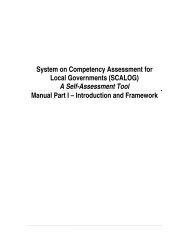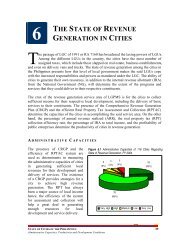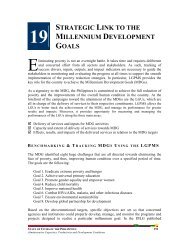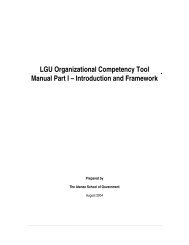PED guidebook main sxn rev6. FINAL.pdf - LGRC DILG 10
PED guidebook main sxn rev6. FINAL.pdf - LGRC DILG 10
PED guidebook main sxn rev6. FINAL.pdf - LGRC DILG 10
You also want an ePaper? Increase the reach of your titles
YUMPU automatically turns print PDFs into web optimized ePapers that Google loves.
Project Evaluation and Developmentthe project cost. Note that projects that do not involve construction of hard infrastructuredo not require detailed engineering. In such cases, only the detailed design needs to bedone. This includes the arrangements for implementation – project management, funddisbursement and accounting, monitoring and evaluation, etc. If a project is proposedfor external funding, some description of these arrangements may be already requiredbefore a project is approved.4. The next step is to implement the project according to the detailed design. For projectsthat involve construction of hard infrastructure, project operation commences only afterthe structure is built. For other projects, or for projects that include non-infrastructurecomponents, project implementation coincides with project operation. Examples of thelatter are immunization project, supplementary feeding, an irrigation project withtechnical assistance component, etc.5. Some time after the project implementation and operation, it is recommended that an expostevaluation be conducted. Results from the ex-post evaluation can enhance thedesign of future projects in order to increase its effectiveness and efficiency.6. In the next sections, we will be discussing project evaluation and development in thecontext of the project preparation stage. We will also refer to this as the <strong>PED</strong>.D. MAJOR COMPONENTS OF PROJECT EVALUATION AND DEVELOPMENT1 Earlier, we said that Project Evaluation or feasibility study pertains to a whole gamut ofanalyses undertaken to determine if the project is worth pursuing of not. Most manualson project evaluation or feasibility study enumerate and discuss the component studiesthat need to be undertaken. The usual broad classification (or sub-studies are) is thefollowing:• Market analysis• Technical analysis• Financial analysis• Economic analysis• Analysis of externalities• Risk and sensitivity analysisWe briefly describe below the objectives of these studies/analyses. The details areexplained in the subsequent sections.1.1 Market analysis answers the questions:a. Does the current situation imply that there is a shortage in supply of the project’sintended output?b. Is there a demand for the project’s output even in the medium term (say <strong>10</strong>years)?c. If I charge a fee for the use of the project’s output, by how much will demandlikely decrease?1.2 Technical analysis answers the questions:a. Is the proposed project strategy technically sound?b. What are the alternatives to produce the desired project outputs?RGEdillon January 200614
















